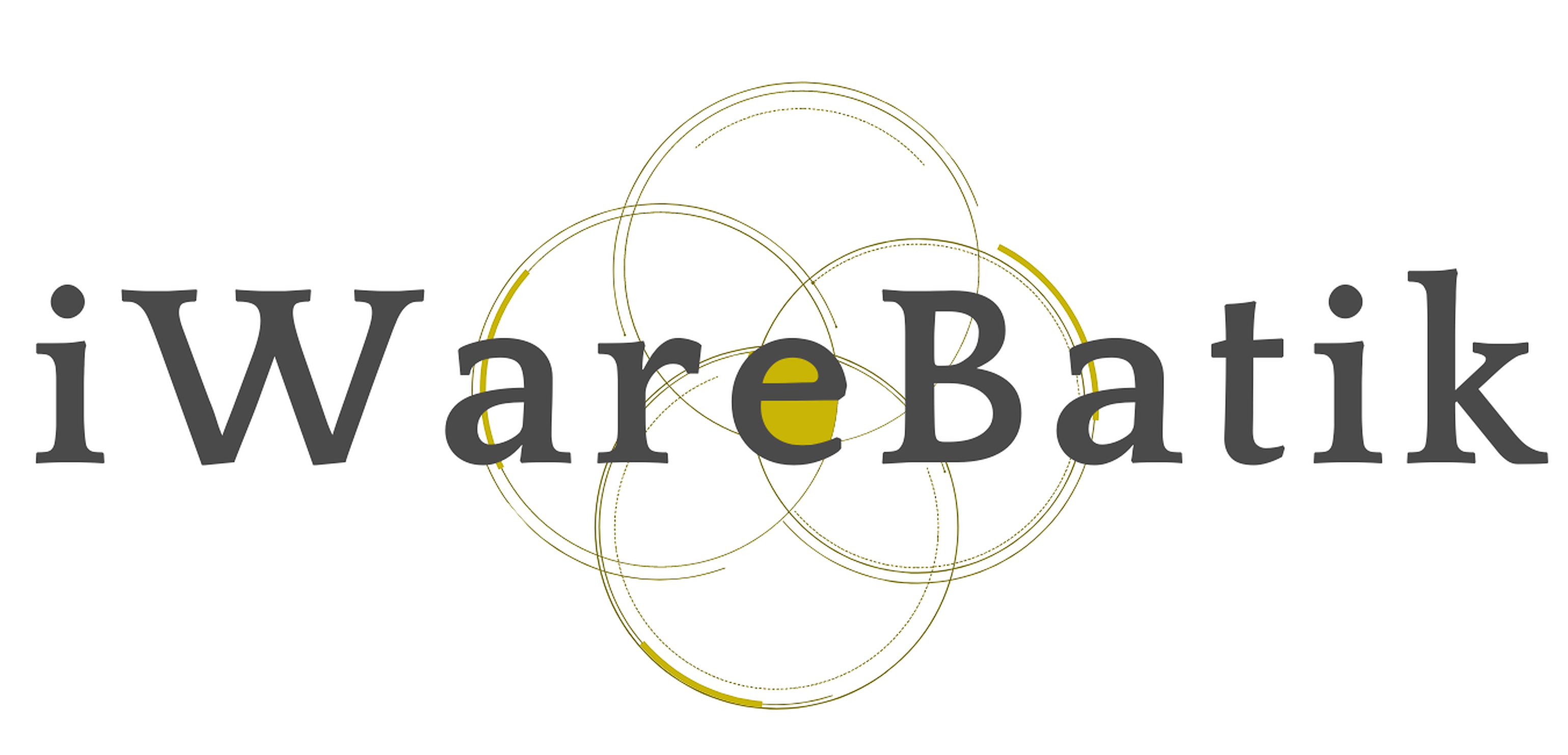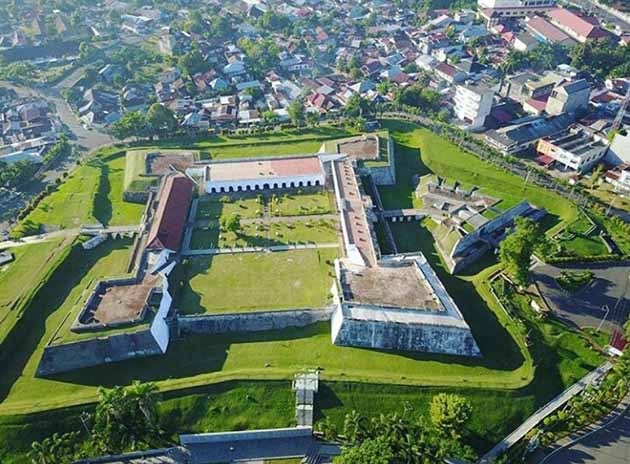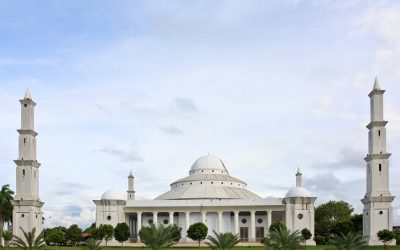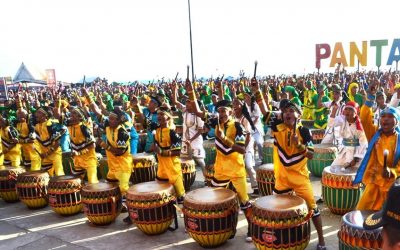Home / Batik Regions – Western Indonesia – Southern Sumatra – Bengkulu / Fort Marlborough
Cultural Destination
Embrace the spirit of the place!
Fort Marlborough
Fort Marlborough in Bengkulu was once built by the British colonial era during 1713-1719 under the leadership of Governor Joseph Callet. After the Fort George in Madras, India, Fort Marlborough lined up as the biggest British fortress in Southeast Asia. The total area of this building is around 44,100 square meters and surrounded by 8.5 meters-height walls. This fort has a unique character as it looks like a turtle-shaped building as seen from above.
Tourist Attractions in Bengkulu
At Taqwa Grand Mosque
Bengkulu also offers spiritual tourism with historical nuances and
Tabut Festival
Bengkulu regional government holds annual the Tabut Festival that takes place in
Bengkulu
Batik Motifs
Besurek Rafflesia
The term “Basurek” refers to a textile that contains letters or inscriptions
Kaganga Tanah Rejang
If Batik Besurek combines Arabic calligraphy motifs, then the Kaganga batik takes
Besurek Rembulan
This batik illustrates praise for God who created the wonderful universe
Discover
Indonesian
Batik
Motifs
Tabir Tanjung
Tanjung flower is a type of Cherry tree flower, which is commonly found in
Desa Na Tolu
The Desa Na Tolu characteristic pattern symbolizes the Batak philosophy of existence and
Gonggong Beruntun
This motif illustrates that a person should maintain a positive attitude and
Ukir Sentani
The Ukir motif is a batik motif that is inspired by various traditional Sentani wood carvings
Daun Lada Hitam
The black pepper motif represents the main commodity of Bangka Belitung
Gigi Haruan Lidi
The Gigi Haruan Lidi motif is taken from the name of the cork fish and is a symbol of
Leuit Sijimat
This motif reflects the daily activities of the Baduy tribe in Banten. The main ornaments of batik motif consist of:
Gorga Simeol-Meol
The Gorga Simeol-meol is a pattern of plant tendrils. it is regarded as a symbol of longevity and
Durian Pecah
Broken Durian motifs depict the foundation of faith. The second half signifies the mastery of
Enggang Dayak
Local people beliefs that hornbills are an incarnation of the Commander of the Birds. It has supernatural
Daun Simpor
This motif is inspired by the Simpor plant (Dillenia Suffruticosa) which is a typical
Daun Sirih
This motif illustrates betel leaves that are used by Lombok communities as traditional
Lipaq Sabe
Lipaq Saqbe contains a simple geometric classical motif with various flower decorations. This textile is
Tenun Bima
The motifs are adopted from Bima woven textile. This pattern has received a great
Gumin Tambun
Based on Hindu mythology, this motif symbolizes lucks, abundant wealth, and
Bale Lumbu
This motif signifies the welfare of the ancient Sasak society. Bale also symbolizes the
Kawung
The Kawung motif was created by Sultan Agung Hanyokrokusumo (1593 – 1645) as a symbolic gift for
Besurek Rafflesia
The term “Basurek” refers to a textile that contains letters or inscriptions
Tengkawang Ampiek
With its many advantages, the Dayaks use this leaf in ritual ceremonies. This plant is a symbol of
Bomba Mawar
This motif means sacred love for family, kingdom, and God; It also illustrates
Kaganga Tanah Rejang
If Batik Besurek combines Arabic calligraphy motifs, then the Kaganga batik takes
Pohon Hayat (Tree of Life)
The Batik motifs in Lampung are dominated by the acculturation of Buddhist and
Tubo Kelapa
Coconut tree is a symbol of a good character and strong mentality. It illustrates the more success a person, the more
Wirasat
Wirasat or divine inspiration is a gift from God. This inspiration is symbolized by
Bultiya
The word ‘Bultiya’ is an acronym of the three major tribes in North Kalimantan, namely
Gajah Way Kambas
The motif illustrates the Lampung’s natural reserve, the Way Kambas. it also symbolizes
Jumputan Bintang
The word Jumputan means the tie-dye technique, while the word “Bintang” refers to
Ikan tambal
The word “Ikan” refers to fish. The philosophical meaning of Ikan Tambal means is
Karawo Mahkuta
Mahkuta refers to Gorontalo’s traditional crown. It represents noble characters of
Tongkonan
Toraja’s traditional house is called Tongkonan. Tongkonan is a place for
Gamolan
This motif illustrates Gamolan, a bamboo musical instrument of Lampung that is
Buketan Bali
The Balinese bouquet (Buketan Bali) is a floral arrangement and the name is
Parang Rusak
Another meaning behind this motif is an unconquerable spirit, symbolized by
Taiganja
Taiganja is a precious gold pendant that shows the social status of the Kaili family. It is
Karawo Pinang
Pinang refers to the Palm areca tree. This motif is considered as the original
Gurdo Solo
Gurdo or garuda bird is the mount of the Indian god Vishnu. As the Sun Bird,
Sido Mulyo
Sidomulyo is one of the classical motifs, which is specifically used for the bride’s costume in
Mahkota Siger
Siger is the crown of a noblewoman in ancient time. It is a symbol of femininity, strength, and
Pinawetengan
The Pinawetengan Batik pattern was taken from a prehistoric inscription in
Honai
The Honai is inspired by the traditional house of the Papuan community living in
Raja Ampat
Raja Ampat motif represents the marine life at Raja Ampat archipelago in
Tampuk Manggis Sasirangan
The motif illustrates the philosophy of the mangosteen fruit, which is
Kerawang Tegak Aceh
The Vertical Upright (Kerawang Tegak) Motif symbolizes a person who has a strong
Tanah Liek
The word “Tanah Liek” refers to clay in Minang language. It is also known as
Awan Berarak
Awan Berarak is a combination of Dayak motifs and Malay patterns. The word ‘Awan Berarak’ means the
Salakanagara
Salakanagara batik motif illustrates the first kingdom in the Betawi land
Srimanganti
The name of the Srimanganti motif is derived from Palace’s hallway that connects to
Gedhog Kembang Waluh
a combination of Javanese cultural motif of the Majapahit kingdom (XII-XIV century) with
Jupri Kembang Teh
Kembang Teh illustrates the tendrils of tea plants that grow in the highlands of
Tikar Natuna
The Tikar Natuna motif is adapted from the traditional making of pandanus mats in
Dayak Kamang
Kamang motif is generally found in the Dayak tribe shield because it is believed to
Ake Patra
Ake is related to the divinity and the composition of the universe. It is a symbol of
Pala Salawaku
This motif illustrates the unique weapons of the Maluku region, namely
Kain Cual
Cual textile tradition has existed since the 17th century. The word “Cual” refers to
La Galigo
La Galigo is a literary work of the Buginese Epic that has 300 thousand epic lines. It is considered even
Bekantan Pakis
This motif represents Pakis Haji (Polystichum setiferum), an endemic plant in
Kaharingan
The Kaharingan or ‘tree of life’ based on the Dayak tribes’ belief system. This tree symbolizes
Pati-Pati Pinehiku
It symbolizes the hierarchy in society and the social status of the Mekongga
Teguh Bersatu
This batik motif shows the strength of the people of Kupang. It also represents a sense of
Kasih Tak Sampai
‘Kasih Tak Sampai’ is an idiom in the Indonesian language which refers to
Sandeq
Sandeq Boat is a symbol of the maritime importance of the West Sulawesi region. The greatness of
Hiu Taliyasan
Indonesia is also home to the world’s largest fish, the whale shark (Rhincodon typus). Hiu Taliyasan refers to
Cengkeh
The clove flower motif is the main commodity of the Tolitoli Regency. This motif represents
Malinau Cultural Festival
You will witness a unique competition that might not be found other than in
Pattimura
Pattimura is the name of an Indonesian hero who fought against colonialism in
Rangkiang
The word “Rangkiang” refers to the rice granary in the Minangkabau language. It symbolizes
Kuda Kupang
Horses symbolize wealth. It contains noble values of virtuous characters that bring
Dayak Taghol
Dayak Taghol has a distinctive style of four curved lines and small dots. This motif represents
Lok Baintan Floating Market
As you can imagine, the most authentic thing is that you can buy things and even
Biji Kopi
The coffee seeds motif illustrates the pride of local coffee specialities in
Wakatobi
It symbolizes the coastal beauty of the Wakatobi island and the symbol of Patra symbolizes



